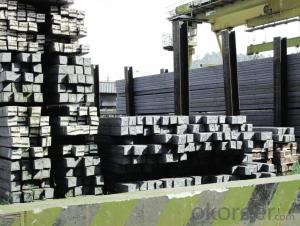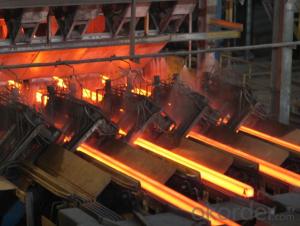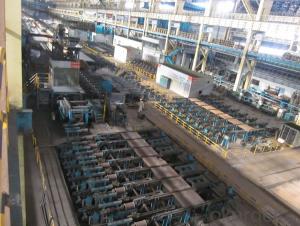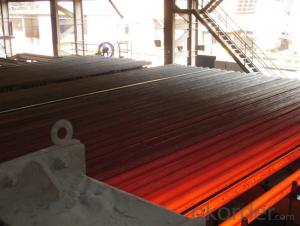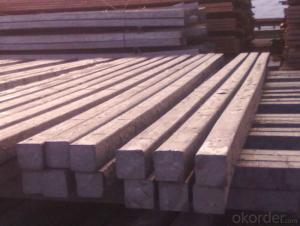Hot Rolled Steel Billet 3SP Standard 120mm
- Loading Port:
- Shanghai
- Payment Terms:
- TT OR LC
- Min Order Qty:
- 100 m.t.
- Supply Capability:
- 10000 m.t./month
OKorder Service Pledge
OKorder Financial Service
You Might Also Like
Structure of Hot Rolled Steel Billet 3SP Standard 120mm

Description of Hot Rolled Steel Billet 3SP Standard 120mm
Prepainted Rolled steel Coil is a kind of coated steel coil/sheet. With the cold rolled steel of different strength and thickness as substrate, it is produced through applying Al-Zn coat on both faces by hot dip process. In its coating, Al accounts for about 55%, Si 1.6%, while the remaining is Zn. Aluminum zinc coils enjoys both the physical protective feature and durability of Al and the electrochemical protective property of Zn. And its surface has bright silver color and regular embossed-like figure, which are highly decorative. RAL Scale Z35 Prepainted Rolled Steel Coil for Construction Roofing

Main Feature of Hot Rolled Steel Billet 3SP Standard 120mm
1.Corrosion resistance: It mainly depends on the zinc protection. When the zinc being worn,
2. Heat resistance: steel sheet has excellent heat resistance, can withstand high temperatures over 300 centigrade, and is similar with aluminized steel high temperature oxidation resistance. It often used in chimney pipes, ovens, fluorescent lighting device and the device cover.
3. Heat reflective: Galvanized steel plate heat-reflective high rate is twice as galvanized steel, often used to make insulation materials. RAL Scale Z35 Prepainted Rolled Steel Coil for Construction Roofing
Applications of Hot Rolled Steel Billet 3SP Standard 120mm
1. Construction and building: roofing; ventilating duct; handrail; partition panel;etc.
2. Electric appliance: refrigerator; washing machine; refrigerator; DVD;etc.
3.Transportation: oil tank; gas tank;road sign; etc.
4.Agriculture constructions :barn; etc.RAL Scale Z35 Prepainted Rolled Steel Coil for Construction Roofing
5.Others:vending machine; game machine; auto parts spare parts etc.
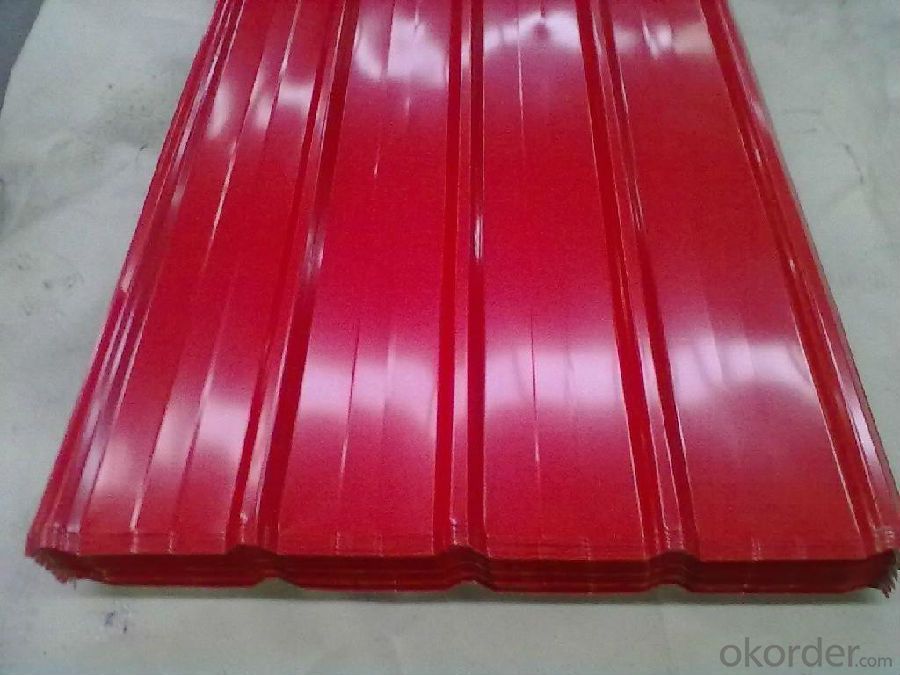
Specifications of Hot Rolled Steel Billet 3SP Standard 120mm
Product | Hot Rolled Steel Billet 3SP Standard 120mm |
Material Grade | SGCC / SGCH / DX51D+AZ, etc |
Thickness | 0.5-3.0mm |
Width | 700-1500mm |
Tolerance | Thickness: +/-0.02mm , Width:+/-2mm |
Zinc-coating | AZ30-150g/m2 |
Technique | Raw material: Hot rolled steel coil --> Cold rolled_>hot dipped galvalume |
Surface | Dried, Chromated, Unoiled,RAL Scale Z35 Prepainted Rolled Steel Coil for Construction Roofing |
Spangle | Regular spangle , small spangle, zero spangle |
ID | 508MM 610MM |
Coil weight | 25MT max |
Export package | Cardboard inner sleeves, Waterproof paper, galvanized steel covered and steel strip packed |
FAQ of Hot Rolled Steel Billet 3SP Standard 120mm
We have organized several common questions for our clients,may help you sincerely:
1. What is the minimum order quantity ?
Our MOQ is 100 mt for each size each specification. Usually we can offer discount if can buy large QTY once. RAL Scale Z35 Prepainted Rolled Steel Coil for Construction Roofing
2. How long can we receive the product after ordering?
Our general delivery time is 30 days after confirmation, but so some special orders, we have offer special delivery time
3. How to guarantee the quality of the products?
We have established the international advanced quality management system ,every link from raw material to final product we have strict quality test;We resolutely put an end to unqualified products flowing into the market. At the same time, we will provide necessary follow-up service assurance.
4. What is the payment?
We accept T/T, L/C
- Q:What are the different methods of steel billet surface painting?
- There are several methods of steel billet surface painting, including spray painting, powder coating, electrostatic coating, and dip coating. Spray painting involves using compressed air or a sprayer to apply a liquid paint to the surface of the billet. Powder coating involves applying a dry powder to the surface, which is then heated to create a durable and protective coating. Electrostatic coating uses an electric charge to attract the paint particles to the billet surface, creating an even and uniform coating. Dip coating involves immersing the billet in a tank of paint, allowing the paint to adhere to the surface. Each method has its own advantages and is chosen based on factors such as the desired finish, cost, and environmental considerations.
- Q:How are steel billets used in the production of fasteners?
- Steel billets are used in the production of fasteners as they serve as the raw material for manufacturing various types of fasteners such as bolts, screws, and nuts. These billets are heated and then forged or rolled to shape them into the desired fastener form. The resulting fasteners possess high strength and durability, making them suitable for a wide range of applications in industries like construction, automotive, and manufacturing.
- Q:What are the common surface defects found in steel billets?
- Some common surface defects found in steel billets are scale, cracks, laps, seams, and surface decarburization.
- Q:What does "billet" mean?
- Steelmaking and continuous casting of steel products are mainly used for steel rolling, such as round bar, wire rod, sheet metal and so on
- Q:What are the potential applications of steel billets in the food and beverage industry?
- Steel billets have numerous potential applications in the food and beverage industry. One of the main uses is in the production of stainless steel equipment, such as tanks, vessels, and processing machinery. Stainless steel is a preferred material in the food and beverage industry due to its corrosion resistance, durability, and hygienic properties. Steel billets are often used to manufacture stainless steel pipes and fittings, which are essential components in food and beverage processing plants. These pipes and fittings are used for conveying fluids, gases, and food products, ensuring a safe and reliable transportation system. In addition, steel billets can be used to produce stainless steel bar and rod, which are used in various applications such as kitchen equipment, cutlery, and utensils. Stainless steel bar and rod are highly resistant to staining, rusting, and chemical corrosion, making them ideal for use in food preparation and serving. Furthermore, steel billets can be used to manufacture stainless steel sheets and plates, which are used for food storage and packaging. Stainless steel sheets and plates provide a hygienic and durable surface for food storage containers, countertops, and shelving units. They are easy to clean, resistant to bacterial growth, and do not react with acidic or alkaline food products. Overall, steel billets play a crucial role in the food and beverage industry by providing the necessary raw material to manufacture stainless steel equipment, pipes, fittings, bar, rod, sheets, and plates. The use of stainless steel enhances food safety, ensures product integrity, and contributes to the efficient and hygienic operation of food and beverage processing facilities.
- Q:How are steel billets used in the production of wind turbine towers?
- Steel billets play a crucial role in the production of wind turbine towers. These billets, which are essentially semi-finished steel products, are used as the raw material in the manufacturing process of wind turbine towers. Firstly, steel billets are carefully selected based on their specific properties such as strength, durability, and corrosion resistance. These properties are vital as wind turbine towers need to withstand strong winds, harsh weather conditions, and long-term exposure to environmental elements. Once the appropriate steel billets are chosen, they undergo a series of manufacturing processes. These processes often include heating, rolling, and shaping the billets into the desired form for wind turbine towers. Heating the steel billets to high temperatures makes them malleable and easier to shape. After the heating process, the steel billets are rolled into long cylindrical shapes, resembling the final structure of the wind turbine tower. These rolled billets are then forged and welded together to form seamless tower sections. The welding process ensures the structural integrity and stability of the tower. Furthermore, steel billets are also used in the construction of the tower's foundation. Large steel billets are embedded deep into the ground to provide a stable base for the tower. This helps to anchor the tower securely, preventing any potential movements or instability. Overall, steel billets are fundamental in the production of wind turbine towers as they provide the necessary strength and durability required for these structures. Without steel billets, it would be nearly impossible to construct wind turbine towers that can withstand the demanding conditions they are exposed to.
- Q:What are the different types of steel billet surface treatment defects?
- Some common types of steel billet surface treatment defects include pitting, scaling, decarburization, scratches, and cracks.
- Q:How do steel billets contribute to the shipbuilding industry?
- The shipbuilding industry heavily relies on steel billets, which have a significant role in the construction of ships. These semi-finished products are molten steel that has solidified into a specific shape, usually a square or rectangular block. They are obtained through continuous casting or ingot casting. Steel billets play a crucial role in providing the raw material for fabricating various ship components. These billets undergo further processing, such as rolling, forging, or extrusion, to create different structural elements like plates, beams, angles, and channels. These components are then used in constructing the ship's hull, decks, bulkheads, and other structural parts. Moreover, steel billets possess advantageous properties that make them ideal for shipbuilding. Their high strength and durability ensure the ship's structural integrity and longevity, enabling it to withstand the harsh marine environment and constant exposure to seawater. Additionally, steel billets have excellent weldability, facilitating efficient and reliable joining of different components during ship assembly. Furthermore, the use of steel billets in shipbuilding offers a cost-effective solution. Steel is readily available and abundant, making it a cost-efficient material choice for ship construction. Furthermore, steel is highly recyclable, allowing for the reuse of steel billets and reducing environmental impact. In conclusion, steel billets are essential in the shipbuilding industry as they provide the raw material for fabricating various ship components. Their high strength, durability, weldability, and cost-effectiveness make them an ideal choice for constructing ships that can withstand the demanding marine environment. Ultimately, steel billets contribute to the safe and reliable operation of ships, supporting the growth and development of the shipbuilding industry.
- Q:What are the different types of straightening methods used for steel billets?
- There are several types of straightening methods used for steel billets, including rotary straightening, roller straightening, and hydraulic straightening. Rotary straightening involves rotating the billet while applying pressure to straighten it. Roller straightening uses a series of rollers to apply pressure and straighten the billet. Hydraulic straightening uses hydraulic force to straighten the billet. Each method has its own advantages and may be chosen based on the specific requirements of the steel billet.
- Q:How are steel billets used in the production of forgings?
- Steel billets are an essential component in the production of forgings. They serve as the initial raw material that undergoes a series of processes to transform into the desired forged product. Firstly, the steel billets are heated to a specific temperature to make them more malleable and easier to work with. This process is known as preheating and is crucial as it allows for easier shaping and deformation during the forging process. Next, the heated steel billets are placed into a forging press or hammer, where they are subjected to immense pressure and force. This pressure causes the billets to deform and take on the desired shape. The forging press applies compressive forces to the billets, while the hammer strikes them repeatedly to achieve the desired shape. During the forging process, the steel billets undergo plastic deformation, meaning they change shape without breaking. This deformation allows for the elimination of any internal defects or inconsistencies within the billet, resulting in a stronger and more reliable final forged product. Once the desired shape is achieved, the forged product is cooled down, either through air cooling or quenching, to stabilize its structure and enhance its mechanical properties. This cooling process helps to increase the strength and hardness of the forged product. In summary, steel billets play a crucial role in the production of forgings. They are heated, shaped under immense pressure, and then cooled to create the final forged product. The use of steel billets in the forging process enables the production of durable, high-quality forged products with superior strength and reliability.
1. Manufacturer Overview |
|
|---|---|
| Location | |
| Year Established | |
| Annual Output Value | |
| Main Markets | |
| Company Certifications | |
2. Manufacturer Certificates |
|
|---|---|
| a) Certification Name | |
| Range | |
| Reference | |
| Validity Period | |
3. Manufacturer Capability |
|
|---|---|
| a)Trade Capacity | |
| Nearest Port | |
| Export Percentage | |
| No.of Employees in Trade Department | |
| Language Spoken: | |
| b)Factory Information | |
| Factory Size: | |
| No. of Production Lines | |
| Contract Manufacturing | |
| Product Price Range | |
Send your message to us
Hot Rolled Steel Billet 3SP Standard 120mm
- Loading Port:
- Shanghai
- Payment Terms:
- TT OR LC
- Min Order Qty:
- 100 m.t.
- Supply Capability:
- 10000 m.t./month
OKorder Service Pledge
OKorder Financial Service
Similar products
New products
Hot products
Related keywords
